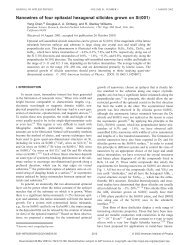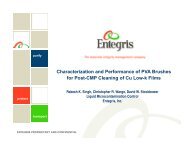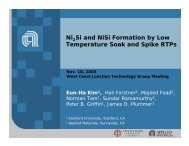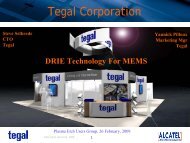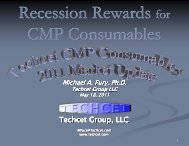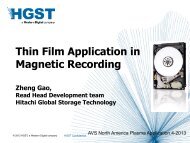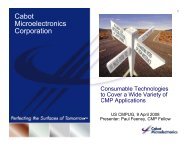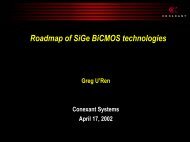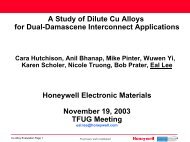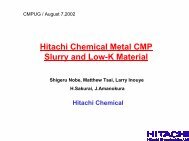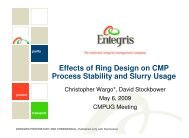Cu CMP Cleaning - Avsusergroups.org
Cu CMP Cleaning - Avsusergroups.org
Cu CMP Cleaning - Avsusergroups.org
Create successful ePaper yourself
Turn your PDF publications into a flip-book with our unique Google optimized e-Paper software.
<strong>Cu</strong> <strong>CMP</strong> <strong>Cleaning</strong>Aqueous, Alkaline ChemistryMarch 2002
Outline• Introduction• ESC Chemical Formulation Overview• <strong>Cleaning</strong> Requirements• SummaryFebruary 20022
Introduction• Focus is on developing a robust <strong>Cu</strong> <strong>CMP</strong> cleaningprocess that achieves the cleaning objectives with awide range of polishing processes• A two-step cleaning process has been studied tomeet these requirements.– Good results were observed initially– Since the writing of the paper issues appeared with a 2-step, high pH/low pH clean• Single-step cleaning process is desiredFebruary 20023
Versatility in <strong>Cu</strong> Processing• ESC has developed alkalinechemical formulations that areversatile enough to be used formany <strong>Cu</strong> integration applications– Post-<strong>CMP</strong> cleaning– Post-Etch <strong>Cleaning</strong>– Miscellaneous cleans• In <strong>Cu</strong> processing applications,the main concern is particle andresidue removal withoutcorrosion of the bulk <strong>Cu</strong> andother exposed films• Base formula can be customizedbased on requirementsPost-<strong>CMP</strong>CleanMiscellaneousCleansPost-EtchCleanApplication region that is addressedby the “base chemistry”February 20024
ESC Chemical Formulations• Base Formulation- ESC 784– High pH (>10) with buffering agent– Oxygen scavenger– Provides some chelating effect– Aqueous solution (>80% water) that is easily diluted• <strong>Cu</strong>stomization using optional additives– Surfactants– Fluorides– Solvents– Chelating agents– Additional corrosion inhibitors• Process Flexibility– Time, Temperature, Tool and ConcentrationFebruary 20025
Particle Removal• Defect counts afterblanket <strong>Cu</strong> <strong>CMP</strong> toTEOS.• 25-wafer lot testedLPD's >0.2µm (Tencor 6420)10080604020ESC 784 (average = 15.1)0135791113151719212325Wafer IDFebruary 20027
<strong>Cu</strong> CompatibilityESC Products include proprietary <strong>Cu</strong> inhibitors thatare effective in preventing <strong>Cu</strong> corrosionUntreated showing <strong>CMP</strong> contaminationTreated w/ ESC 784 solution(ambient, 30 sec, 20:1)February 20028
<strong>Cu</strong> Etch Rate for Post-<strong>CMP</strong>10<strong>Cu</strong> Etch Rate vs. Concentration4-Point Probe DataEtch Rate (Å/min)8642784 @ 22˚C784 @ 50˚C00% 20% 40% 60% 80% 100%Concentration (wt. %)February 20029
2-Step Clean• A 2-step clean, high pHfollowed by low pH,shows good <strong>Cu</strong>contamination removal• Evidence from leakagecurrent data• However, damage tofront-end devicesreported compared toone-step, high pH clean• Also, unique corrosiondefect observed<strong>Cu</strong>mulative Probability100908070605040302010010.90.80.70.6Normalized DataESC 784 + MR10ESC 784 onlyESC 784 + ElectracleanESC 784 + DHF0.5February 200210
Corrosion Defect• <strong>Cu</strong> corrosion defectseen with 2-stepcleaning process• Observed at severalcustomers withdifferent chemistries• High pH, followed bylow pH in each case• High pH-only and lowpH-only do not createthis defectFebruary 200211
1-Step, High pH Clean• Several customers have qualified ESC 784 as asingle-chemistry clean• <strong>Cu</strong> contamination level has been demonstrated to bewithin spec without additional cleaning steps• Development of improved chelating efficacy toaddress future needs for <strong>Cu</strong> contamination levelsand to increase the <strong>CMP</strong> process windowFebruary 200212
ESC 784 vs. TMAHDefects on Patterned <strong>Cu</strong>/Oxide Waferafter <strong>CMP</strong> Process300<strong>Cu</strong> Concentration on DielectricSurface Following <strong>Cu</strong> <strong>CMP</strong> Processon Patterned Wafers1,000Average # ofdefects250200150100Processed in SprayToolProcessed inDouble-sided ScrubberAtoms/cm 2 x E 10TOF-SIMS100500TMAH ESC 784 DIW TMAH ESC 78410DIW TMAH ESC 784• ESC 784 shows better particle removal performance without mechanicalassistance• ESC 784 shows slightly better particle removal performance in scrubberprocess• ESC 784 shows significantly better <strong>Cu</strong> contamination removal performanceFebruary 200213
Applied MIRRA MESA Data• <strong>Cu</strong>stomer SPCdata154-Week Patterned WaferProcess Data for ESC 784• Patterned wafertested daily forparticle defects• One-chemicalclean with 784only on brushesin Mesa cleanerDefects (KLA)1050032 21420 021210120 020 0 01 2 3 4 5 6 7 8 9 10 11 12 13 14 15 16 17 18 19 20 21 22 23 24 25 26 27 28212031DaysFebruary 200214
Preliminary Data on Modified Formulation• TEOS wafercontaminated with<strong>Cu</strong>Cl solution• 782 is 784 withchelating agent added• Encouragingpreliminary results• Further testing ofproduct wafersscheduledAtoms/cm 2 x E 101.E+161.E+151.E+141.E+131.E+121.E+111.E+101.E+09PrePostMR-10 / 784 782-A 782-B 782-CFebruary 200215
BTA Removal• BTA is typically used between the polish processand the cleaning step.• Removal is desired to prevent defects and increaseelectrical resistance.• High pH cleaning chemistries can remove BTA morereadily than low pH chemistries• XPS data demonstrates thisFebruary 200216
<strong>CMP</strong> Equipment Performance• Contact <strong>Cleaning</strong>– Double-sided scrubbers– “Disk-type” scrubbers• Non-Contact <strong>Cleaning</strong>– Single wafer megasonics– Batch megasonics• Single-pass chemistry is typical• Ambient temperature operation• No particle brush loading in scrubbers• Megasonic performance enhancement for particle removalFebruary 200217
<strong>CMP</strong> Equipment Supplier Experience• AMAT Mirra Mesa• Lam TERES• IPEC/Speed-Fam 776• Ebara• Verteq Goldfinger• Verteq Cobra VcS• DNS AS2000• Ontrak DSS/Synergy• FSI Mercury• SSEC ScrubberFebruary 200218
Megasonic <strong>Cleaning</strong> EnhancementStatic <strong>Cleaning</strong> Angle TestVerteq Goldfinger Megasonic SystemContaminated WaferMeasured Static <strong>Cleaning</strong> Angle120100806040200Solution A(pH 8)Oxalic Acid(pH 5.3)100:1 NH4OH(pH 11)Slurry ASlurry BSlurry CSolution B(pH 5)ESC 774(pH >11.0)GoldfingerMegasonicTransducerArea cleaned bychemical andmegasonic energyWafer is cleaned with megasonics andchemistry without wafer rotationArea not cleaned bychemical andmegasonic energyStatic AngleFebruary 200219
Cost of Ownership• 20:1 to 40:1 dilution– 10 - 30 ml of concentrate per wafer• No particle loading in brushes• Easily rinsed with DI water• 30-45 sec chemical process time can be performedin a single station with excellent results• Reduced waste treatment cost compared tofluorinated chemistriesFebruary 200220
<strong>CMP</strong> <strong>Cleaning</strong> Summary• <strong>Cleaning</strong> performance and cleaning processdependent on polish process and cleaning tool• Excellent particle removal performance• Good <strong>Cu</strong> contamination removal with excellent <strong>Cu</strong>compatibility• 1-step process is possible to replace 2-step processand its defect and yield issues• Successfully used with variety of process equipment• Low cost of ownershipFebruary 200221



